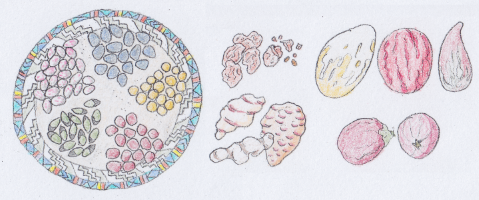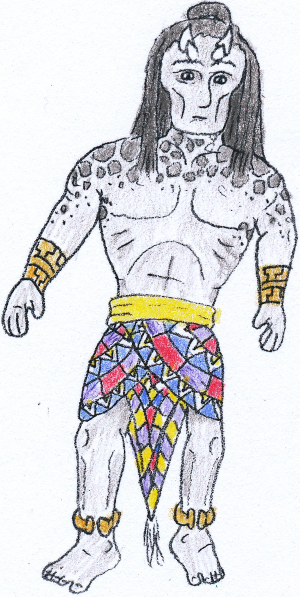Znagrúks
Znagrúkic: Znagrúk /znaːkrukh/
Gláðic: Þlaglúgvab /θlaːkluːkvaːp/ (sing. Þlaglúgvaba /θlaːkluːkvaːpaː/)
Hyrric: Hjakrújat /çaːkhrujaːth/
Jeihókic: Neinó /neiːnouː/
The Znagrúks1 are large, humanoid people inhabiting the Znagrúk Empire in the southwestern Múlíat Mountains of southern Dragonía. They've long been a major rival of the surrounding Gobíl cultures of the mountains, and since the fall of the Órax Empire in Sjorg Desert to the west, their civilization has been the only prominent one in southern Dragonía.
On the surface, there's notably little difference between Znagrúk men and women, though the men tend to be a bit taller, have deeper voice and smaller markings.
Men and women alike prefer long hair, often tied in one or more knots at the back of the head, and sometimes bleached with lead.
Their cuisine also incorporates various ingredients and culinary traditions introduced by the other peoples of the empire and beyond; figs and lupin beans were first grown by Hyrríans, while the use of mead and certain insects originates among Jeihókans, and black-and-green úxúat beans (avhúke) were first obtained though contact with Kúxes to the north.
Common spices include saffron and úrg fruits, the seeds from the latter give a fizzy sensation similar to carbonated drinks. Notable dishes include:Hurhe- and antelope bean stew (apjam/apam)
Salted lúrp bass with úxúat beans (grilúrp hi avhúke)
Lamb with figs (zyzgret)
Left: Assorted beans. Center: Dried úrg fruits- and nuts and hurhe. Right: Melons and figs.
Emperors are expected to know hymns and prayers in virtually every language of the empire, even several extinct ones, in order to properly communicate with the gods.
Nem is god of the sky, often depicted with the head of Ortú Cormorants.
Územ Nartá is god of the tallest mountain in Dragonía (also known as Exirglarp), first child of heaven and earth, usually depicted with three heads, either those of a Znagrúk or bird of prey. Znagrúk emperors are believed to be descendants of Územ Nartá.
Ykú is goddess of the earth, often depicted as a a woman with four bird wings, either growing out of her back or instead of arms.
Hyrric: Hjakrújat /çaːkhrujaːth/
Jeihókic: Neinó /neiːnouː/
The Znagrúks1 are large, humanoid people inhabiting the Znagrúk Empire in the southwestern Múlíat Mountains of southern Dragonía. They've long been a major rival of the surrounding Gobíl cultures of the mountains, and since the fall of the Órax Empire in Sjorg Desert to the west, their civilization has been the only prominent one in southern Dragonía.
Appearance and abilities
Znagrúks are among the largest people of Dragonía, possessed of great strength and endurance, although their movements are somewhat sluggish compared to Gobíls. Aside from their size, Znagrúks are easily recognized by the four small, curved horns on their forehead; the horns appear around the age of three-five. They have deep-set eyes without irises, four digits on each hand but five on each foot. Their skin is of various shades of grey, with adults having irregular black markings on the upper body, while the hair is dark grey or black.On the surface, there's notably little difference between Znagrúk men and women, though the men tend to be a bit taller, have deeper voice and smaller markings.
History
The first Znagrúk societies appeared at the end of last ice age, along with a number of other sapient species in the mountains. Since they move slower than most other people of Dragonía, Znagrúks never expanded throughout the mountains as much as the Gobíls did later on, but instead used their great size and strength to build some of the earliest fortified settlements there to deter invaders. Over the millennia, other peoples have joined the Znagrúks for protection against outside threats in exchange for sharing their knowledge with them.Culture
Apparel
Znagrúk clothing is generally light and colourful, consisting of little more than loincloth and -occasionally- sandals, while the upper body is rarely covered in order to emphasize the markings there. Priests and priestesses traditionally wear tall, conical hats made of leather, and monarchs similar headgear made of gold. Heavy jewelry made of gold, precious and semiprecious stones is popular, both to show status as well for apotropaic purpose.Men and women alike prefer long hair, often tied in one or more knots at the back of the head, and sometimes bleached with lead.
Art
Architecture
Traditionally, larger structures are made of cyclopean masonry, using boulders only Znagrúks could stack up easily, while smaller buildings are built out of sun-dried bricks. While the latter technique originated among Gobíl Krekkúxes in Sjorg Desert, the Znagrúks were the first to make use of glaze bricks for decoration. In many cities, particularly the capital of Ut, glazed bricks of certain colour are used for different neighbourhoods, and only temples and especially palaces feature bricks of many colours.Cuisine
Znagrúk cuisine is mostly based on various plants endemic to the region, most importantly tubers knows as Hurhe along with figs (zyz) and several varieties of beans and melons (tamlá). Domesticated Sjerg Antelopes (utu) and sheep (yznók) provide much of the meat, while fish -particularly Apjy Tuna and Lúrp Basses- and shellfish are harvested by the coast of Súrkniss Sea to the south and Hahagak Sea to the east.Their cuisine also incorporates various ingredients and culinary traditions introduced by the other peoples of the empire and beyond; figs and lupin beans were first grown by Hyrríans, while the use of mead and certain insects originates among Jeihókans, and black-and-green úxúat beans (avhúke) were first obtained though contact with Kúxes to the north.
Common spices include saffron and úrg fruits, the seeds from the latter give a fizzy sensation similar to carbonated drinks. Notable dishes include:
Language
A number of different languages are spoken by Znagrúks, both their own and those of the other peoples inhabiting their empire. Like most people of southern Dragonía, the Znagrúks make use of an alphabet rather than logography, which has notably simpler letters than those used by Gobíls.Religion
The Znagrúks worship mountains as deities, children of the earth and sky, with temples dedicated to the highest mountain peaks within the empire and beyond. Commoners are not allowed to worship at these temples, instead doing so in private or at small shrines outside cities, and priests and priestesses only perform rituals within the temple courtyards; only emperors are allowed inside temples to worship the gods directly.Emperors are expected to know hymns and prayers in virtually every language of the empire, even several extinct ones, in order to properly communicate with the gods.
Notable deities
Nem
Nem is god of the sky, often depicted with the head of Ortú Cormorants.
Územ Nartá
Územ Nartá is god of the tallest mountain in Dragonía (also known as Exirglarp), first child of heaven and earth, usually depicted with three heads, either those of a Znagrúk or bird of prey. Znagrúk emperors are believed to be descendants of Územ Nartá.
Ykú
Ykú is goddess of the earth, often depicted as a a woman with four bird wings, either growing out of her back or instead of arms.
Funeral rites
Znagrúks practice burials of different kinds depending on their status in life. Warriors and women who died during childbirth are buried in cemeteries outside cities beneath -often elaborate- tombstones, aristocrats are laid to rest in family tombs within cities, while commoners are buried in shallow, unmarked graves in the wilderness.Warfare
Znagrúk's size and strength alone is enough make any warrior think twice before provoking them, though historically the Znagrúks have long had to defend themselves from invasions and border disputes with neighbouring Gobíls. Whenever their imposing walls and towers along the border fail, throwing boulders at the invaders has usually worked well enough.1Original icelandic: Znagrúkar, singular: Znagrúki
Origin/Ancestry
Southwestern Múlíat Mountains.
Geographic Distribution
Related Organizations
Znagrúkic









Comments